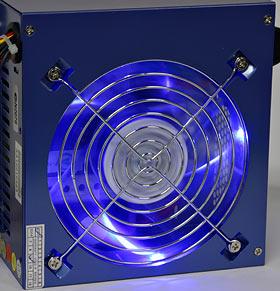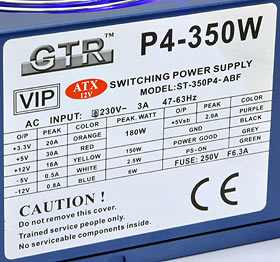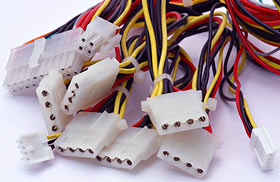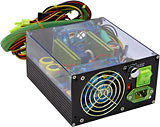
Quick Shot review 15:
GTR-350ATX low noise PSU
Review date: 7 January 2004.
Last modified
03-Dec-2011.
PC tweakers have a thing for fancy Power Supply Units.
A plain old grey steel PSU simply won't do for a show-off PC. You need a shiny enclosure, multiple fans with gold finger guards, zillions of plugs, and big chunky gold-anodised heat sinks on the power semiconductors. Acrylic windows and LED lighting are optional, but also recommended.
There's some justification for this fetish. Even a really high-spec PSU isn't terribly expensive compared with the other major components of a tweaky PC, and an inadequate PSU can cause various bizarre problems.
If you want to be depressingly practical, though, the fact is that the vast majority of PCs today will run just fine from any quality 300 watt PSU. Even most fancy "enthusiast" machines with top-spec everything are likely to come in under 300 watts.
Many "300 watt" PSUs aren't good enough to run a stacked PC. Their specifications are inflated, though it can take rather complex testing to find out how badly. But a boring old grey-steel 300W PSU from a solid mainstream manufacturer like AOpen really is very likely to be good enough for all but the most outrageous PCs.
Tweaking enthusiasts should take note of this, even if they intend to buy a show-off PSU for their tiny god. When you buy your show-off PSU, also buy a nice cheap boring old AOpen or similar, and keep that drab PSU as a spare. A spare PSU is a good thing to have, when your fancy one drops dead just before the LAN party.
One segment of the PC market doesn't want a plain PSU or most of the fancy ones, though. That segment is the few, the proud, the easily annoyed - people who want a silent PC.
Many fancy PSUs have manually or automatically speed-controlled fans that are often very quiet at their minimum speed, but they may still be too loud for lounge-room or bedroom PC applications. Especially if there's more than one fan in the PSU, which there probably will be.
Hence, allow me to present the GTR-350ATX. It's a nominal 350 watt PSU with a bit of pose value, and truly extraordinary quietness.
Here in Australia, you can buy the GTR-350ATX from Aus PC Market for $AU93.50 including delivery anywhere in the country. That's a decent price - if it's a decent PSU, of course.
The first thing you notice about the 350ATX is its enormous fan. It's only got one fan, but it's a doozie - a 120mm giant, with considerably more swept area than the two 80mm fans that most fancy PSUs contain.
Power the PSU up and you can see where the pose value comes from. This is one of those clear-blade LED-lit fans all the kids are playing with these days.
The fan turns at a very lazy pace, though, shifting only about as much air as a twin-fan speed-controlled PSU will with its fans at minimum speed. Because this is one big slow fan rather than two smaller faster ones, however, it's very close to completely inaudible when it's running. If a computer's got any other ventilation fan in it, it'll probably be louder than the 350ATX.
The down side of this is that you're almost certain to need another ventilation fan, because the 350ATX is unlikely to provide enough airflow to ventilate a PC case all by itself.
The design of the 350ATX is partly responsible for this. The fan sucks air into the PSU, but there are exhaust grilles at the front and the back of the 350ATX's box, which prevent it from removing air from a computer efficiently. The rear panel's practically all grille and the front one's grille is smaller, so there's a bias towards the back, and you could make the airflow more conventional by blocking off the inside grille with tape. Even if you did that, though, the 350ATX's airflow still wouldn't keep a decently powerful PC cool.
If you're building a system with a Via C3 CPU and some low-grunt video adapter, you could possibly scrape through with just a 350ATX for ventilation, provided you tidied your cables and chose a case with a lot of inlet vents. I really think you'd be likely to need another fan even then, though.
So, think of the 350ATX as not having a fan at all. It certainly sounds as if it doesn't have one.
Testing PSU capabilities is hard, but snap-judging them is easy. All you have to do is look at the sticker on the side.
Rule of thumb: If the sticker makes no sense, the PSU's dodgy. See my old review here for more on how crummy PSU manufacturers pump up the numbers.
The rail ratings on the GTR-350ATX's sticker only add up to 348.5 watts (the +5VSB rail's two amp rating is there, but in an odd place), so this PSU isn't quite a real 350W unit, even if the ratings are 100% accurate. It ought to manage the same output as a brand name 300W PSU without too much trouble, though, and that's likely to be more than adequate for anyone building a super-quiet PC.
Like most not-too-grunty PSUs, the 350ATX doesn't provide a forest of plugs, but it's got enough. You get the usual ATX and ATX12V, six "Molex" drive power plugs, and two floppy power connectors. There's no AUX connector for server boards and no SATA drive power plugs either. But this isn't one of those skimpy four-Molex, one-floppy, wires-not-long-enough units. It'll do nicely for most people.
Overall
GTR are not exactly a household name, but Aus PC Market have been selling GTR-badged gear (some of it rather hilarious) for a while now. This is not something they'd do if GTR products had the nasty reliability problems that some cheap unknown brands exhibit.
So, while I haven't tested a phalanx of 350ATXs for 20,000 hours to establish an MTBF curve, I wouldn't feel nervous about using one of these things in my own PC. The 350ATX isn't top flight brand name quality, but it isn't expensive either, and it fills a real need.
If you want a PC that you have to look at to tell whether it's on, a GTR-350ATX will get you closer to your goal. At $AU93.50 delivered, it's a good deal.
Buy one!
Aus PC Market no longer sell the GTR-350ATX. They've got several other 120mm-fan
units in their
power supply department, though!






